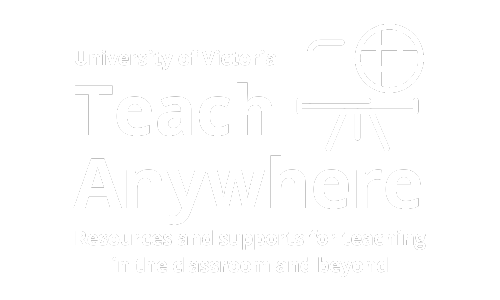Objectives of the process
The objectives of the peer review of teaching process are to enhance and encourage reflection on an Faculty’s teaching, as well as improving student learning. In the peer review of teaching process, there are two main roles: the reviewer (a faculty member assigned to conduct the review) and the instructor (a faculty member who is being reviewed). Below are the four main stages in a summative peer review of teaching process from both points of view. You can also use these steps in a formative peer review process.
Pre-observation
In this stage, the reviewer and instructor will set up a meeting and plan for the review. There are a few responsibilities that are described below:
Reviewer
- Review the course materials: syllabus, Brightspace course page
- Consider organization of the course and student learning experience
- Have a conversation with the instructor to learn more about class expectations and context
Instructor
- It is up to the instructor to select a date for the teaching observation
- Provide any necessary background information to support the reviewer ahead of time
- Have a conversation with the reviewer to learn more about class expectations and context
- Provide clear expectations to students of what would happen during the review (ie. who will be attending, what they will observe, if any recording will be occuring)
Observation
In this stage, the observation of teaching takes place. Depending on course context, reviewers may choose to review a class lecture, tutorial, discussion group, lab, performance, seminar, workshop, studio work or other learning activity.
When preparing feedback for the instructor, keep in mind that useful feedback is descriptive and constructive, specific and focused on supporting student learning. Use the feedback as an open avenue for further discussion and provide clear suggestions for improvement and learning.
Below are some criteria to keep in mind and suggestions on what to look for when providing feedback for the instructor:
Quality of Learning Environment
- Promotes community building, with a clear opening to course and contact information
- Provides clear instructions and accessible navigation of LMS, course materials, and/or other learning technologies (e.g. Zoom, Echo360, Teams etc.) as well as technology privacy guidelines
- Expectations of course are clearly communicated, including how to participate in any learning activities (synchronous and asynchronous) and classroom etiquette
- Significant documents and links to campus resources are easily accessible and accurate (see Teach Anywhere post: components of a well designed syllabus)
- Language is respectful, clear and accessible, including the Territory Acknowledgement
Course format and content
- Follows clear course outcomes and is in line with students’ prior knowledge of concepts
- Course activities are well organized and planned, using a mix of learning strategies and instructional methods and show evidence of Universal Design for Learning principles
- Pace of class and materials are appropriate, allowing time for reflection, clarification of concepts and breaks
- Provides effective use of voice, non-verbal communication, and appropriate movement throughout the room
- Demonstrates enthusiasm and mastery of the subject
Student engagement
- Actively engages students in the learning process and addresses student concerns and issues effectively
- Provides opportunities for student questions and incorporates their ideas, including encouraging feedback
Note:
There may be other categories or criteria deemed necessary for your discipline, context or teaching type (i.e., lab, tutorial, perfomance etc.). Feel free to include these in your peer review documents.
Other considerations as an reviewer
Depending on what you plan to review, you may want to video-tape or record the teaching observation (prior consent is needed) for reference. Plan ahead on where you want to sit or how you want to position yourself if it is an online teaching observation. You can also be added to asynchronous discussions if course is fully online. It is up to you and the reviewer whether you want to interact in the process and be introduced prior to the teaching observation.
Post-observation
In this stage, we suggest planning a follow-up meeting between the reviewer and the instructor. This typically involves a discussion of the data collected, as well as questions and suggestions that emerged from the review of materials and the observation.
The main focus of the meeting is on effective teaching and learning, and the two parties engage in a mutual conversation to identify areas of growth and development.
Based on this discussion, an action plan is developed that outlines specific steps the instructor can take to improve their teaching skills and support the learning needs of their students. Ultimately, the goal of the follow-up meeting is to promote ongoing professional growth and development for the instructor, and to ensure that students are receiving the best possible learning experience.
Formal letter
In the final stage of peer review of teaching, the reviewer will create a formal letter or report, reflecting on the teaching they observe in a brief written analysis. The style of letter will be dependent on the type of teaching observation and department goals. The purpose of this letter is usually to accompany an instructor’s dossier for promotion and tenure materials.
Reflective summary
To accompany the formal letter, a brief written analysis by the instructor and possibly the peer reviewer is added, which highlights what was learned about the process and about their teaching. It is an opportunity to reflect on what to start, what to stop and what to continue.
Reflection questions
- What is your take-away about your teaching? About student learning?
- What questions about teaching and learning have emerged from this process?
- What changes might make the peer review of teaching process more helpful?
Looking for more training?
We can support you in training for peer review through consultations and training to your department, as well as train interested peer reviewers.
Explore the sections
Peer Review of Teaching Learning Guide: Overview and Considerations
Learn the difference between formative and summative feedback, principles and considerations for peer review
Peer Review of Teaching Learning Guide: Template
Use our peer review template in your department and explore additional opportunites for learning and training



